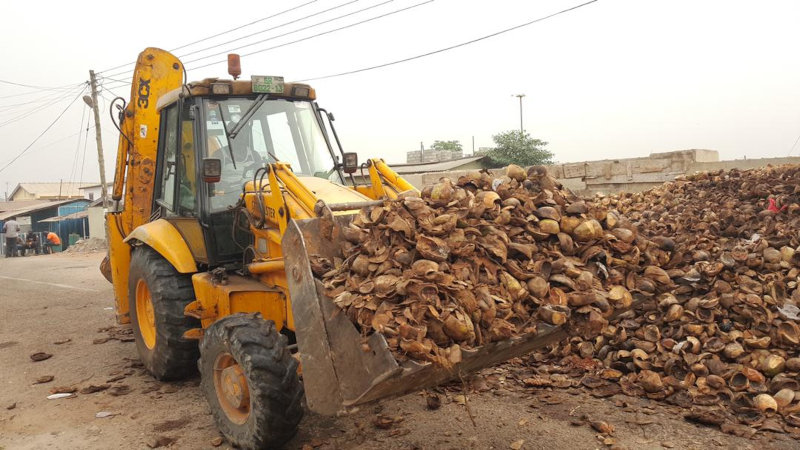Ghanaian company Zaacoal, launched in 2016, manufactures charcoal from coconut waste. Here is an interview with the founder Amin Sulley, about how he started the business and some of the mistakes he made along the way.
1. How did you come up with the idea for Zaacoal?
I came up with the concept as early as 2011 but at the time it didn’t have a name. I had been looking for ways to make use of the coconut waste that was found everywhere in Accra. My university was in the centre of Accra and every day, on my way to class, I was confronted by many people selling coconut in the street. I was curious and wondered what they did with their coconut waste. I engaged with the sellers and many told me they paid companies to collect the waste. Some of them would drive their carts to the beach and dispose of it there.
I was so intrigued, I went to almost every neighbourhood to find out where they were dumping it. At that stage, I didn’t know what I was going to do with the information, it was just thoughts rattling around in my head.
One time we went to buy local food from a vendor and I discovered the woman was cooking using coconut waste for the fire instead of firewood. That was when the idea for Zaacoal was conceived: firewood is the raw material for charcoal … would it be possible to use this coconut waste to make charcoal?
Coconut waste ready for processing into charcoal
2. Tell us about the manufacturing process.
I had no clue how to make charcoal so I travelled to the northern part of the country where I learnt about the procedure. I came back to Accra and decided to modernise the process. To make charcoal, you set a material alight and block off oxygen to the fire. If oxygen gets to the fire, it burns to ash; if you limit the oxygen flow, it turns to charcoal. I found a tomato can, put some pieces of coconut in it, lit it and covered it with sand. It worked really well.
During a university vacation, I decided to experiment. I moved from the tomato can to a bucket and from the bucket to a small barrel and then drums. Soon, we were lining up 10, 15 drums. Every sample we produced we gave to the neighbours to use. They liked it and offered us much-needed feedback so we were able to continue improving our method.
I met with the wood charcoal sellers to learn more about the charcoal business and asked so many questions. One of the most crucial learnings was that people don’t buy in bulk. When the average Ghanaian household is about to cook, they send someone to buy two or five cedis’ worth of charcoal. I realised I had to enter the market with packaging that was small and convenient.
Production of charcoal from coconut waste
I invested my university class fees in small machines to perfect the process and, when my school fees were depleted, I couldn’t go back. I had to be self-reliant but wasn’t yet selling anything. I searched for investors and finally convinced a few family members to jump on board. I had to keep at it because it is something I am so passionate about it. I always have pieces of coconut charcoal in my pocket so that I can show it to people I meet.
3. Where do you source the coconut waste?
Initially, we asked a few coconut sellers to drop off their waste with us. Very quickly, the whole place was filled with coconuts. Disposing of the waste was a big problem for coconut sellers and word soon got around.
Zaacoal has never paid for coconuts. We provide the coconut sellers with a way to dispose of their waste. It’s a win-win for everyone.
4. Where are your products sold? How competitive is this industry?
Our target market is the average Ghanaian household that uses charcoal for cooking.
For now, the wood charcoal sellers are our only competition but we anticipate there will be more competitors, considering the success of Zaacoal.
We started by convincing the neighbourhood wood charcoal sellers to stock our product. Their customers trust them and we had to win them over so they could convince the customers to change to coconut charcoal. We handed sellers free bags of Zaacoal. In return, they gave us their feedback and we improved the product. Once they saw how well it performed, they became our ambassadors and we used their existing network to get into the market. We price Zaacoal to enable the charcoal sellers to make more money selling Zaacoal than selling wood charcoal.
We do have other retailers: big stores situated in shopping malls, but this represents only about 5-10% of our market.
Packaged charcoal ready for sale
5. Tell us about your biggest mistake.
We made a lot of mistakes because we did not fully understand our customer. We started out selling to the everyday Ghanaian charcoal user. Along the line, we found that retailers in shopping malls were importing charcoal and selling it at higher prices. We opted to target some of these retailers and moved away from the everyday consumer which was a big mistake. Even though the product sells for a higher price in the big retail stores, the people who buy there aren’t regular users: they maybe buy once a week for a barbeque versus the everyday charcoal user who cooks with it every single day.
We strategised and brought out separate packaging and products for the two markets. The casual buyers require slow-burning charcoal for a barbeque whereas the everyday charcoal user wants a high, long-lasting heat for cooking. As you know, most African meals need to be on the fire for a long time. So we revised the formulation for these two markets.
Because we had no data on this industry, we are forced to do everything on our own and it took a long time to get to where we are. If there had been people who knew the industry well and were prepared to share their experiences and expertise, we would have gotten here much earlier.
Source: howwemadeitinafrica



